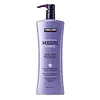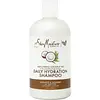What's inside
What's inside
 Key Ingredients
Key Ingredients

 Benefits
Benefits

 Concerns
Concerns

 Ingredients Side-by-side
Ingredients Side-by-side

Water
Skin ConditioningSodium Cocoyl Isethionate
CleansingCocamidopropyl Hydroxysultaine
CleansingPotassium Cocoyl Glycinate
Disodium Cocoyl Glutamate
CleansingSodium Lauroyl Methyl Isethionate
CleansingSodium Lauroyl Sarcosinate
CleansingDecyl Glucoside
CleansingPotassium Cocoate
EmulsifyingGlycereth-26
HumectantGlycol Distearate
EmollientCocamidopropylamine Oxide
CleansingPhenoxyethanol
PreservativeParfum
MaskingSodium Cocoyl Glutamate
CleansingPEG-120 Methyl Glucose Dioleate
EmulsifyingMethyl Gluceth-20
HumectantQuaternium-91
Amodimethicone
Acrylates Copolymer
Citric Acid
BufferingDicaprylyl Ether
EmollientPolyquaternium-10
Guar Hydroxypropyltrimonium Chloride
Skin ConditioningChlorphenesin
AntimicrobialTrisodium Ethylenediamine Disuccinate
PPG-3 Benzyl Ether Myristate
EmollientGlyceryl Oleate
EmollientC11-15 Pareth-7
EmulsifyingPolyquaternium-39
Laureth-9
EmulsifyingPhospholipids
Skin ConditioningGlycerin
HumectantHydrolyzed Vegetable Protein Pg-Propyl Silanetriol
Skin ConditioningPolyquaternium-55
Sodium Benzoate
MaskingPanthenol
Skin ConditioningTrideceth-12
EmulsifyingGlycine Soja Oil
EmollientAcetic Acid
BufferingTetrasodium EDTA
Benzoic Acid
MaskingSodium Hydroxide
BufferingDisodium EDTA
Potassium Sorbate
PreservativeHydrolyzed Pea Protein Pg-Propyl Silanetriol
Skin ConditioningCaprylyl Glycol
EmollientTocopheryl Acetate
AntioxidantHelianthus Annuus Seed Oil
EmollientAlcohol
AntimicrobialTocopherol
AntioxidantArgania Spinosa Kernel Oil
EmollientAscorbic Acid
AntioxidantPersea Gratissima Oil
Skin ConditioningCopaifera Officinalis Resin
MaskingPassiflora Edulis Seed Oil
EmollientIsomalt
HumectantEuterpe Oleracea Fruit Oil
Skin ConditioningAloe Barbadensis Leaf Extract
EmollientCucumis Sativus Fruit Extract
EmollientLycium Barbarum Fruit Extract
AstringentPunica Granatum Extract
AstringentMalus Domestica Fruit Cell Culture Extract
Skin ConditioningQuaternium-95
UV AbsorberPropanediol
SolventCamellia Sinensis Leaf Extract
AntimicrobialPersea Gratissima Fruit Extract
EmollientXanthan Gum
EmulsifyingLecithin
EmollientVitis Vinifera Fruit Cell Extract
Skin ConditioningVitis Vinifera Seed Extract
AntimicrobialPentaerythrityl Tetra-Di-T-Butyl Hydroxyhydrocinnamate
AntioxidantWater, Sodium Cocoyl Isethionate, Cocamidopropyl Hydroxysultaine, Potassium Cocoyl Glycinate, Disodium Cocoyl Glutamate, Sodium Lauroyl Methyl Isethionate, Sodium Lauroyl Sarcosinate, Decyl Glucoside, Potassium Cocoate, Glycereth-26, Glycol Distearate, Cocamidopropylamine Oxide, Phenoxyethanol, Parfum, Sodium Cocoyl Glutamate, PEG-120 Methyl Glucose Dioleate, Methyl Gluceth-20, Quaternium-91, Amodimethicone, Acrylates Copolymer, Citric Acid, Dicaprylyl Ether, Polyquaternium-10, Guar Hydroxypropyltrimonium Chloride, Chlorphenesin, Trisodium Ethylenediamine Disuccinate, PPG-3 Benzyl Ether Myristate, Glyceryl Oleate, C11-15 Pareth-7, Polyquaternium-39, Laureth-9, Phospholipids, Glycerin, Hydrolyzed Vegetable Protein Pg-Propyl Silanetriol, Polyquaternium-55, Sodium Benzoate, Panthenol, Trideceth-12, Glycine Soja Oil, Acetic Acid, Tetrasodium EDTA, Benzoic Acid, Sodium Hydroxide, Disodium EDTA, Potassium Sorbate, Hydrolyzed Pea Protein Pg-Propyl Silanetriol, Caprylyl Glycol, Tocopheryl Acetate, Helianthus Annuus Seed Oil, Alcohol, Tocopherol, Argania Spinosa Kernel Oil, Ascorbic Acid, Persea Gratissima Oil, Copaifera Officinalis Resin, Passiflora Edulis Seed Oil, Isomalt, Euterpe Oleracea Fruit Oil, Aloe Barbadensis Leaf Extract, Cucumis Sativus Fruit Extract, Lycium Barbarum Fruit Extract, Punica Granatum Extract, Malus Domestica Fruit Cell Culture Extract, Quaternium-95, Propanediol, Camellia Sinensis Leaf Extract, Persea Gratissima Fruit Extract, Xanthan Gum, Lecithin, Vitis Vinifera Fruit Cell Extract, Vitis Vinifera Seed Extract, Pentaerythrityl Tetra-Di-T-Butyl Hydroxyhydrocinnamate
Water
Skin ConditioningDecyl Glucoside
CleansingCocamidopropyl Betaine
CleansingSodium Lauroyl Lactylate
EmulsifyingGlycol Stearate
EmollientGlycol Distearate
EmollientSodium Cocoyl Isethionate
CleansingSodium Methyl Cocoyl Taurate
CleansingGlycerin
HumectantCocos Nucifera Oil
MaskingCaprylic/Capric Triglyceride
MaskingButyrospermum Parkii Butter
Skin ConditioningAloe Barbadensis Leaf Juice
Skin ConditioningPanthenol
Skin ConditioningAlgae Extract
EmollientEquisetum Arvense Extract
AstringentTocopherol
AntioxidantRosa Canina Fruit Oil
EmollientArgania Spinosa Kernel Oil
EmollientCoconut Acid
CleansingPrunus Amygdalus Dulcis Oil
Skin ConditioningAcacia Senegal Gum Extract
Cocos Nucifera Fruit Extract
EmollientCocos Nucifera Fruit Juice
EmollientCaprylhydroxamic Acid
Caprylyl Glycol
EmollientGuar Hydroxypropyltrimonium Chloride
Skin ConditioningSodium Benzoate
MaskingPolyquaternium-7
Sodium Phytate
Stearamide Amp
Parfum
MaskingWater, Decyl Glucoside, Cocamidopropyl Betaine, Sodium Lauroyl Lactylate, Glycol Stearate, Glycol Distearate, Sodium Cocoyl Isethionate, Sodium Methyl Cocoyl Taurate, Glycerin, Cocos Nucifera Oil, Caprylic/Capric Triglyceride, Butyrospermum Parkii Butter, Aloe Barbadensis Leaf Juice, Panthenol, Algae Extract, Equisetum Arvense Extract, Tocopherol, Rosa Canina Fruit Oil, Argania Spinosa Kernel Oil, Coconut Acid, Prunus Amygdalus Dulcis Oil, Acacia Senegal Gum Extract, Cocos Nucifera Fruit Extract, Cocos Nucifera Fruit Juice, Caprylhydroxamic Acid, Caprylyl Glycol, Guar Hydroxypropyltrimonium Chloride, Sodium Benzoate, Polyquaternium-7, Sodium Phytate, Stearamide Amp, Parfum
 Reviews
Reviews

Ingredients Explained
These ingredients are found in both products.
Ingredients higher up in an ingredient list are typically present in a larger amount.
You may know this ingredient as argan oil. Argan Oil has antioxidant, hydrating, and soothing properties.
Studies have shown argan oil can help fight again radical damage from the sun. This makes it effective at preventing hyperpigmentation.
Large amounts of vitamin E found in argan oil helps the skin retain water. Argan oil also contains fatty acids such as linoleic acid, oleic acid, and palmitic acid. It is also a good source of lipids.
Another benefit of argan oil is skin-soothing. It can help reduce inflammation-related skin symptoms.
Argan Oil is effective at regulating sebum production in pores. This can make it effective at treating hormonal acne.
Traditionally, argan oil was used for its antibacterial and antifungal properties. However, argan oil contains fatty acids that may make it not fungal-acne safe.
Argan Trees are native to Morocco.
Learn more about Argania Spinosa Kernel OilCaprylyl Glycol is a humectant and emollient, meaning it attracts and preserves moisture.
It is a common ingredient in many products, especially those designed to hydrate skin. The primary benefits are retaining moisture, skin softening, and promoting a healthy skin barrier.
Though Caprylyl Glycol is an alcohol derived from fatty acids, it is not the kind that can dry out skin.
This ingredient is also used as a preservative to extend the life of products. It has slight antimicrobial properties.
Learn more about Caprylyl GlycolDecyl Glucoside is a glucose-based surfactant and emulsion stabilizer. It is created by reacting glucose with the fatty acids from plants.
Surfactants help clean the skin by trapping oil, sebum, and dirt to be washed away. As an emulsion stabilizer, it stabilizes the ingredients in a product by preventing them from separating.
This ingredient is biodegradable and non-toxic. This ingredient is commonly found in baby shampoos.
Decyl Glucoside is sometimes used to stabilize the UV filter Tinosorb.
Learn more about Decyl GlucosideGlycerin is already naturally found in your skin. It helps moisturize and protect your skin.
A study from 2016 found glycerin to be more effective as a humectant than AHAs and hyaluronic acid.
As a humectant, it helps the skin stay hydrated by pulling moisture to your skin. The low molecular weight of glycerin allows it to pull moisture into the deeper layers of your skin.
Hydrated skin improves your skin barrier; Your skin barrier helps protect against irritants and bacteria.
Glycerin has also been found to have antimicrobial and antiviral properties. Due to these properties, glycerin is often used in wound and burn treatments.
In cosmetics, glycerin is usually derived from plants such as soybean or palm. However, it can also be sourced from animals, such as tallow or animal fat.
This ingredient is organic, colorless, odorless, and non-toxic.
Glycerin is the name for this ingredient in American English. British English uses Glycerol/Glycerine.
Learn more about GlycerinGlycol Distearate serves as a pearlizing or opacifying agent in cosmetic products.
It's often included in cleansers and haircare products to give them a lustrous or shimmering appearance.
It is derived from stearic acid, a natural fatty acid commonly found in vegetable oils and animal fats.
Glycol Distearate isn't fungal acne safe.
Learn more about Glycol DistearateThis ingredient is derived from guar gum.
It is a conditioning ingredient, meaning it helps soften skin and hair.
Panthenol is a common ingredient that helps hydrate and soothe the skin. It is found naturally in our skin and hair.
There are two forms of panthenol: D and L.
D-panthenol is also known as dexpanthenol. Most cosmetics use dexpanthenol or a mixture of D and L-panthenol.
Panthenol is famous due to its ability to go deeper into the skin's layers. Using this ingredient has numerous pros (and no cons):
Like hyaluronic acid, panthenol is a humectant. Humectants are able to bind and hold large amounts of water to keep skin hydrated.
This ingredient works well for wound healing. It works by increasing tissue in the wound and helps close open wounds.
Once oxidized, panthenol converts to pantothenic acid. Panthothenic acid is found in all living cells.
This ingredient is also referred to as pro-vitamin B5.
Learn more about PanthenolParfum is a catch-all term for an ingredient or more that is used to give a scent to products.
Also called "fragrance", this ingredient can be a blend of hundreds of chemicals or plant oils. This means every product with "fragrance" or "parfum" in the ingredients list is a different mixture.
For instance, Habanolide is a proprietary trade name for a specific aroma chemical. When used as a fragrance ingredient in cosmetics, most aroma chemicals fall under the broad labeling category of “FRAGRANCE” or “PARFUM” according to EU and US regulations.
The term 'parfum' or 'fragrance' is not regulated in many countries. In many cases, it is up to the brand to define this term.
For instance, many brands choose to label themselves as "fragrance-free" because they are not using synthetic fragrances. However, their products may still contain ingredients such as essential oils that are considered a fragrance by INCI standards.
One example is Calendula flower extract. Calendula is an essential oil that still imparts a scent or 'fragrance'.
Depending on the blend, the ingredients in the mixture can cause allergies and sensitivities on the skin. Some ingredients that are known EU allergens include linalool and citronellol.
Parfum can also be used to mask or cover an unpleasant scent.
The bottom line is: not all fragrances/parfum/ingredients are created equally. If you are worried about fragrances, we recommend taking a closer look at an ingredient. And of course, we always recommend speaking with a professional.
Learn more about ParfumSodium Benzoate is a preservative. It's used in both cosmetic and food products to inhibit the growth of mold and bacteria. It is typically produced synthetically.
Both the US FDA and EU Health Committee have approved the use of sodium benzoate. In the US, levels of 0.1% (of the total product) are allowed.
Sodium benzoate works as a preservative by inhibiting the growth of bacteria inside of cells. It prevents the cell from fermenting a type of sugar using an enzyme called phosphofructokinase.
It is the salt of benzoic acid. Foods containing sodium benzoate include soda, salad dressings, condiments, fruit juices, wines, and snack foods.
Studies for using ascorbic acid and sodium benzoate in cosmetics are lacking, especially in skincare routines with multiple steps.
We always recommend speaking with a professional, such as a dermatologist, if you have any concerns.
Learn more about Sodium BenzoateSodium cocoyl isethionate is a natural ingredient from coconut oil. It is an ultra gentle cleanser that gives a nice foam without drying the skin or impacting the skin barrier.
The amount of foam created depends on the amount of sodium cocoyl isethionate used in the product.
This ingredient also helps improve the spreadability of a product.
Learn more about Sodium Cocoyl IsethionateTocopherol (also known as Vitamin E) is a common antioxidant used to help protect the skin from free-radicals and strengthen the skin barrier. It's also fat soluble - this means our skin is great at absorbing it.
Vitamin E also helps keep your natural skin lipids healthy. Your lipid skin barrier naturally consists of lipids, ceramides, and fatty acids. Vitamin E offers extra protection for your skin’s lipid barrier, keeping your skin healthy and nourished.
Another benefit is a bit of UV protection. Vitamin E helps reduce the damage caused by UVB rays. (It should not replace your sunscreen). Combining it with Vitamin C can decrease sunburned cells and hyperpigmentation after UV exposure.
You might have noticed Vitamin E + C often paired together. This is because it is great at stabilizing Vitamin C. Using the two together helps increase the effectiveness of both ingredients.
There are often claims that Vitamin E can reduce/prevent scarring, but these claims haven't been confirmed by scientific research.
Learn more about TocopherolWater. It's the most common cosmetic ingredient of all. You'll usually see it at the top of ingredient lists, meaning that it makes up the largest part of the product.
So why is it so popular? Water most often acts as a solvent - this means that it helps dissolve other ingredients into the formulation.
You'll also recognize water as that liquid we all need to stay alive. If you see this, drink a glass of water. Stay hydrated!
Learn more about Water